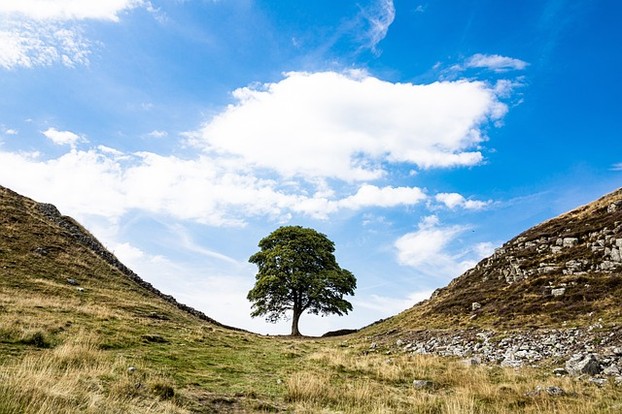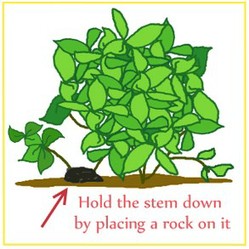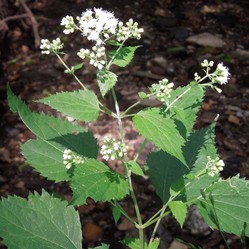Plants grow from seeds, we all know this, but there is a range of other ways by which plants can be made to grow. Propagation by seed is known as sexual propagation, but the alternative way is vegetative propagation. The products of sexual propagation are always the product of both parents, and so you cannot propagate an exact copy of an individual by growing from seed. But vegetative propagation makes clones, exact copies of individuals. There are several distinct ways of doing it, but not all ways work for every plant. Some plants, hybrids, cannot use sexual methods and have to be propagated by vegetative methods Many trees are cultivated using vegetative propagation.
.
Photo courtesy of stencilmist, of Pixabay

The end of the Gap Sycamore
by frankbeswick
Plant propagation methods must be put to work to save a damaged tree.
A much loved tree is felled
Some English people are asking whether a tree can be murdered. Look at the lovely sycamore in the picture, standing in regal splendour in a gap in Hadrian's wall. Then weep. Many Britons have wept in the last few days. During one night a vandal armed with a chain saw cut it down. I cannot name him, as the police have yet to reveal his name. But he [and it is a he] is not going to be popular. But love conquers all, so experts have been consulted to determine what can be done. The simplest method is coppicing. When a healthy tree is felled the stump remains alive, and after a year or so new, vigorous shoots begin to grow from the stump. Each of these has the potential to grow into a full sized trunk. Younger people may live to see the new tree, but we older tree lovers will not be so fortunate Coppicing is sometimes used to give extra vigour to a plant that needs to thrive. This is called coppiced vigour.
Scientists are suggesting that we use cuttings to propagate offspring for the tree. These are not the tree itself, so they differ from coppices, but they are the tree's children. I must bow to the experts here, as sycamores can be propagated by what we call softwood cuttings taken in spring, but Fall [Autumn to Britons] is a time to take what are known as hard wood cuttings. We are currently in Fall, so is it too late? I fear that cuttings might not work, but the experts may have some method for dealing with this problem in the laboratory. Other scientists are collecting the tree's seeds. There is work being done on micropropagation in laboratories, so there is hope.
Cuttings can be taken from different parts of a plant. In some plants the cutting is a healthy green stem. It is severed gently from the main stem and then trimmed by shortening it . Then the leaves are reduced in number leaving two on the cutting. This is to slow down the cutting's metabolism to a rate at which it can survive. Then it is placed in a low nutrient growing medium, e.g. cutting compost, after dipping the base of the cutting in growth hormone. The process then involves keeping the cutting in a warm, moist propagator, some amateur growers use a plastic bag. Then maintain the environment and hope that the cutting thrives.
Cuttings can be taken from various parts of the plant, the exact type of cutting to be taken depends upon the specific plant. Some plants grow from root cuttings Other plants propagate using leaf cuttings, when large leaves are cut down in size and then laid on top of a growing medium. Roots eventually spring out of the leaf. Yet several types of plant, such as strawberries, can be propagated by runners. These are long tendrils that shoot horizontally above ground and take root when and where they touch the soil. Growers use this characteristic to propagate new plants by pegging the runner to the ground so that it takes root in a specific place. At the appropriate time in the cultivation process the runner is severed from the new plant. But this does not work with sycamores.
The Gap Sycamore
 The Gap Sycamore Stencilmist |
Grafting
Could we use grafting. Almost all cultivated fruit trees are grafts. This means that the root and the stem just above the root are from one variety of tree, but the rest of the tree on which the fruit grows is from another variety that the grower wants to fruit. So the grower gets root stocks that have been shortened to maybe eighteen inches and grafts the piece to be grafted onto them. The grower does not want any fruit from the rootstock, which must have been trimmed of all fruiting buds. The rootstocks are planted in the ground several weeks ahead of the grafting to give them time to settle in.
But not just any rootstock will be satisfactory. If you want to produce, for example, Victoria plums on an area where there is little room, you are advised to graft on a dwarfing rootstock, which means that the trees will grow short. If you want something a bit taller, choose a semi-dwarfing root stock, or if you want normally sized trees, choose a standard one .Apples and pears need a rootstock from the plant family to which they belong, but it need not be their own species, and there are some apple varieties that will graft happily with quince. Plums and damsons are so closely related that plum rootstocks will suffice for all.
The technique of grafting is quite simple, for while there are a few techniques, all follow the same principles. The most popular form of grafting is T -budding. In this technique a T shaped cut is made in the root stock and the bark is peeled back. A small piece of wood containing a bud forms the scion, the piece from the tree to be grafted is brought to the rootstock and carefully trimmed to be the shape and size of the cut in the bark. The aim of the process is to ensure that the cambium from both plants comes into contact and remains so for the life time of the graft, which should be the lifetime of the tree. The graft is then bound tightly to the rootstock. Hopefully, the graft will take and you will have propagated a properly grafted fruit tree.
We do not normally graft sycamores, so there is no realistic hope of using grafting to remedy the damage that has been done. All sycamores are prolific with their seeds, so we could grow a new sycamore. But that is defeatism. British tree lovers want the gap sycamore to survive. That is the way to defeat the vandal. One well-intentioned young man planted a tiny sapling to replace the gap tree, but the authorities informed him that in making an unauthorized planting on National Trust land he had broken the law, but his good intentions were recognized, and no action was taken. The sapling was dug up.
I am an Amazon associate and hope to earn money from qualifying purchases on this page.
You might also like
Grow a New Hydrangea Plant From the One You HaveIt's easy to start a new hydrangea bush from one that is already established ...
My Successful Search for Edible LandscapingMany years ago, I went on a quest to find the best edible landscaping for Flo...
White Snakeroot - A Versatile and Little-Known WildflowerWhite snakeroot, Ageratina altissima, is a wildflower native to Eastern North...






 TheThousand Year Garden28 days ago
TheThousand Year Garden28 days ago
 Women of the Gospelson 10/11/2025
Women of the Gospelson 10/11/2025
 Religious Gardenson 08/25/2025
Religious Gardenson 08/25/2025
 Doctor of the Church: John Henry Newmanon 08/03/2025
Doctor of the Church: John Henry Newmanon 08/03/2025




Comments
I think so
The National Trust sounds impressive -- no surprise -- in its sharing such significant sprouts.
Is it one sprout per person?
Your asking this question was coincidental. Recently, two days ago, The National Trust has announced that sprouts grown from cuttings are available anyone who wants to grow them
Your answer 9 comment boxes down, on Mar 9, 2024, that "The National Trust has a tree laboratory where seeds from the Sycamore are being successfully grown. Seedlings are sprouting in pots. In addition the lab is growing grafts from the tree" intrigues me.
How often -- if at all -- might progress reports be issued about the tree grafts and seedlings?
A wise comment indeed.
Yes and that would be the explanation for Passive Aagressive Narcissism
CS Lewis says that the characteristic of evil is to grow yourbego at the expense of another person.
Yes. That sounds about how it all goes.
We have suffered a spate of vandal attacks on our polytunnel in The park, including arson. I believe that the vandals want to make an impact on the world, but rather than do it the hard way by work and sacrifice they choose the easy and lazy way by destroying. They are boosting their egos not by good works but by destroying what good people have done.
I wonder about vandalism. Such a strange past time,
Jo